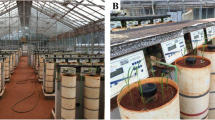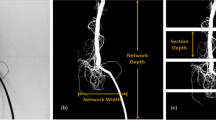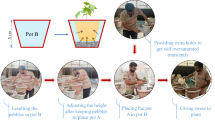Abstract
Roots are the most essential plant part owing to the uptake of water and nutrients. Therefore, phenotyping of root features is vital for improving soybean cultivars. This study evaluated the root morphological and architectural traits of six soybean cultivars using two-dimensional (2D) root imaging. The cultivars were selected from a previous experiment, based on 6 root phenotypes (total root length [TRL], surface area [SA], average diameter [AD], number of tips, number of forks, and main total length [MTL]) in 372 soybean cultivars, (3 each from the highest 5% and lowest 5%). When plants reached two trifoliate leaves stage, both root and shoot parts were harvested and analyzed. According to the analysis of variance, significant variability was observed between the two groups (highest 5% and lowest 5%) for root and shoot morphological traits, but no significant difference was found regarding most root architectural traits. Among three root phenotypes (TRL, SA, and RV [root volume]), IT 21595 and IT 165432 were the highest and lowest, respectively. TRL exhibited a significant positive correlation with other root and shoot morphological traits, such as SA, RV, leaf area, leaf length, and leaf width. Contrastingly, AD showed a significant negative correlation with those parameters. TRL and SA of all the cultivars were classified based on root diameter classes (0–0.5 mm, 0.5–1.0 mm, and 1.0–1.5 mm). A segment of TRL < 0.5-mm root diameter was observed from 74.0 to 75.6% in the highest 5% cultivars and 63.7–75.3% in the lowest 5% cultivars. A segment of SA < 0.5-mm root diameter was observed from 42.0 to 46.9% in the highest 5% cultivars and a relatively reduced ratio (34.5–44.7%) in the lowest 5% cultivars. Conclusively, this research highlighted the characterization of root morphological and architectural traits and some soybean cultivars.





Similar content being viewed by others
References
Asfaw A, Blair MW (2012) Quantitative trait loci for rooting pattern traits of common beans grown under drought stress versus non-stress conditions. Mol Breed 30(2):681–695
Biscarini F, Cozzi P, Casella L, Riccardi P, Vattari A, Orasen G, Perrini R, Tacconi G, Tondelli A, Biselli C, Gattivelli L, Spindel J, McCouch S, Abbruscato P, Valé G, Piffanelli P, Greco R (2016) Genome-wide association study for traits related to plant and grain morphology, and root architecture in temperate rice accessions. PLoS ONE 11(5):e0155425
Christopher J, Christopher M, Jennings R, Jones S, Fletcher S, Borrell A, Manschadi AM, Jordan D, Mace E, Hammer G (2013) QTL for root angle and number in a population developed from bread wheats (Triticum aestivum) with contrasting adaptation to water-limited environments. Theor Appl Genet 126(6):1563–1574
Chung YS, Kim K-S, Hamayun M, Kim Y (2020a) Silicon confers soybean resistance to salinity stress through regulation of reactive oxygen and reactive nitrogen species. Front Plant Sci. https://doi.org/10.3389/fpls.2019.01725
Chung YS, Lee U, Heo S, Silva RR, Na C-I, Kim Y (2020b) Image-based machine learning characterizes root nodule in soybean exposed to silicon. Front Plant Sci 11:520161. https://doi.org/10.3389/fpls.2020.520161
Comas LH, Becker SR, von Cruz MV, Byrne PF, Dierig DA (2013) Root traits contributing to plant productivity under drought. Fron Plant Sci 4:442. https://doi.org/10.3389/fpls.2013.00442
Dayoub E, Lamichhane JR, Schoving C, Debaeke P, Maury P (2021) Early-stage phenotyping of root traits provides insights into the drought tolerance level of soybean cultivars. Agronomy 11(1):188
Fenta BA, Beebe SE, Kunert KJ, Burridge JD, Barlow KM, Lynch JP, Foyer CH (2014) Field phenotyping of soybean roots for drought stress tolerance. Agronomy 4(3):418–435
Foyer C, Lam H, Nguyen H, Siddique K, Varshney R, Colmer T, Cowling W, Bramley H, Mori T, Hodgson J (2016) Neglecting legumes has compromised human health and sustainable food production. Nat Plants 2:16112
Friendly M (2002) Corrgrams: exploratory displays for correlation matrices. Am Stat 56(4):316–324
Ghosh D, Xu J (2014) Abiotic stress responses in plant roots: a proteomics perspective. Front Plant Sci. https://doi.org/10.3389/fpls.2014.00006
Guerrero-Campo J, Fitter AH (2001) Relationships between root characteristics and seed size in two contrasting floras. Acta Oecologica 22(2):77–85
Hertel D, Strecker T, Müller-Haubold H, Leuschner C (2013) Fine root biomass and dynamics in beech forests across a precipitation gradient–is optimal resource partitioning theory applicable to water-limited mature trees? J Ecol 101(5):1183–1200
Hungria M, Bohrer T (2000) Variability of nodulation and dinitrogen fixation capacity among soybean cultivars. Biol Fertil Soils 31(1):45–52
Kim K-S, Kim S-H, Kim J, Tripathi P, Lee J-D, Chung YS, Kim Y (2021) A large root phenome dataset wide-opened the potential for underground breeding in soybean. Front Plant Sci. https://doi.org/10.3389/fpls.2021.704239
Kim Y, Chung YS, Lee E, Tripathi P, Heo S, Kim K-H (2020) Root response to drought stress in rice (Oryza sativa L.). Int J Mol Sci 21(4):1513
Le DT, Nishiyama R, Watanabe Y, Tanaka M, Seki M, Ham LH, Yamaguchi-Shinozaki K, Shinozaki K, Tran L-SP (2012) Differential gene expression in soybean leaf tissues at late developmental stages under drought stress revealed by genome-wide transcriptome analysis. PLoS ONE 7(11):e49522
López-Bucio J, Cruz-Ramırez A, Herrera-Estrella L (2003) The role of nutrient availability in regulating root architecture. Curr Opin Plant Biol 6(3):280–287
Manavalan LP, Guttikonda SK, Nguyen VT, Shannon JG, Nguyen HT (2010) Evaluation of diverse soybean germplasm for root growth and architecture. Plant Soil 330(1):503–514
Park Y-G, Park S-M, Na C-I, Kim Y (2019) Identification of optimal concentration of silicon application and its roles in uptake of essential nutrients in soybean (Glycine max L.). J Crop Sci Biotechnol 22(1):1–10
Prince SJ, Murphy M, Mutava RN, Durnell LA, Valliyodan B, Shannon JG, Nguyen HT (2017) Root xylem plasticity to improve water use and yield in water-stressed soybean. J Exp Bot 68(8):2027–2036
Reis L, Santos e Silva CM, Bezerra B, Mutti P, Spyrides MH, Silva P, Magalhães T, Ferreira R, Rodrigues D, Andrade L (2020) Influence of climate variability on soybean yield in MATOPIBA, Brazil. Atmosphere 11(10):1130
Rincon CA, Raper J, David C, Patterson RP (2003) Genotypic differences in root anatomy affecting water movement through roots of soybean. Int J Plant Sci 164(4):543–551
Tripathi P, Na C-I, Kim Y (2021) Effect of silicon fertilizer treatment on nodule formation and yield in soybean (Glycine max L.). Eur J Agronomy 122:126172
Turner NC, Wright GC, Siddique K (2001) Adaptation of grain legumes (pulses) to water-limited environments: selection for physiological, biochemical, and yield component characteristics for improved drought resistance. In: Saxena NP (ed) Management of agricultural drought: agronomic and genetic options. Science Publishers, Inc., USA, pp 43–80
Uga Y, Sugimoto K, Ogawa S, Rane J, Ishitani M, Hara N, Kitomi Y, Inukai Y, Ono K, Kanno N (2013) Control of root system architecture by DEEPER ROOTING 1 increases rice yield under drought conditions. Nat Genet 45(9):1097–1102
Xiong R, Liu S, Considine MJ, Siddique KH, Lam HM, Chen Y (2021) Root system architecture, physiological and transcriptional traits of soybean (Glycine max L.) in response to water deficit: a review. Physiol Plant 172(2):405–418
Xu W, Cui K, Xu A, Nie L, Huang J, Peng S (2015) Drought stress condition increases root to shoot ratio via alteration of carbohydrate partitioning and enzymatic activity in rice seedlings. Acta Physiol Plant 37(2):9
Zhao C, Liu B, Piao S, Wang X, Lobell DB, Huang Y, Huang M, Yao Y, Bassu S, Ciais P (2017) Temperature increase reduces global yields of major crops in four independent estimates. Proc Natl Acad Sci 114(35):9326–9331
Acknowledgements
This research was supported by Kyungpook National University Research Fund, 2021.
Author information
Authors and Affiliations
Corresponding author
Ethics declarations
Conflict of interest
The authors declare no conflicts of interest.
Additional information
Publisher's Note
Springer Nature remains neutral with regard to jurisdictional claims in published maps and institutional affiliations.
Rights and permissions
About this article
Cite this article
Tripathi, P., Kim, Y. Investigation of root phenotype in soybeans (Glycine max L.) using imagery data. J. Crop Sci. Biotechnol. 25, 233–241 (2022). https://doi.org/10.1007/s12892-021-00126-0
Accepted:
Published:
Issue Date:
DOI: https://doi.org/10.1007/s12892-021-00126-0




